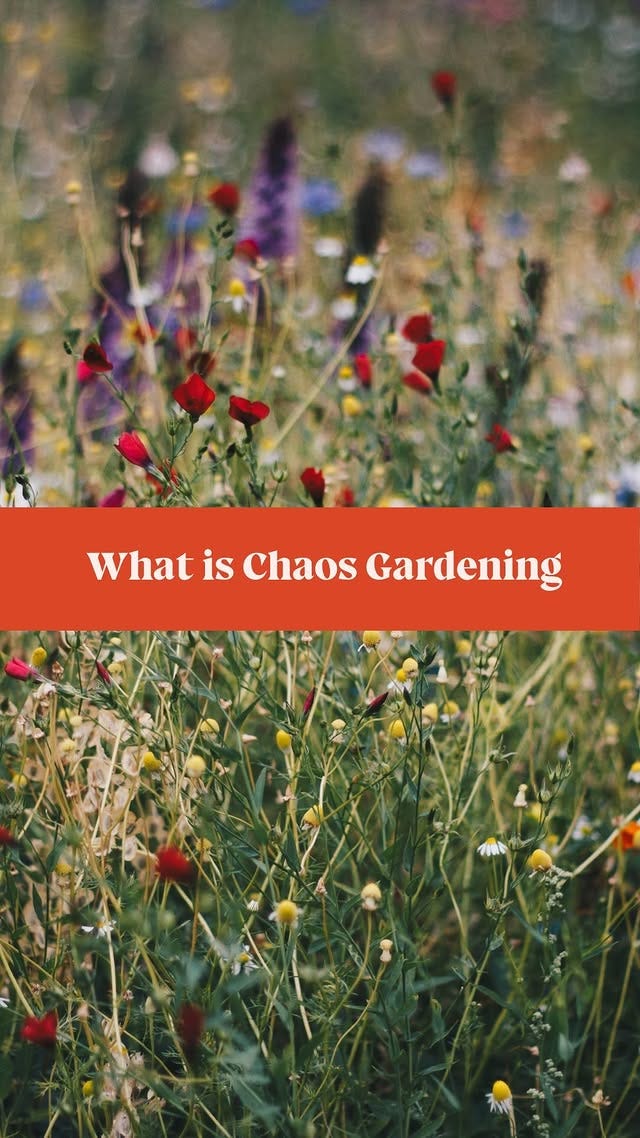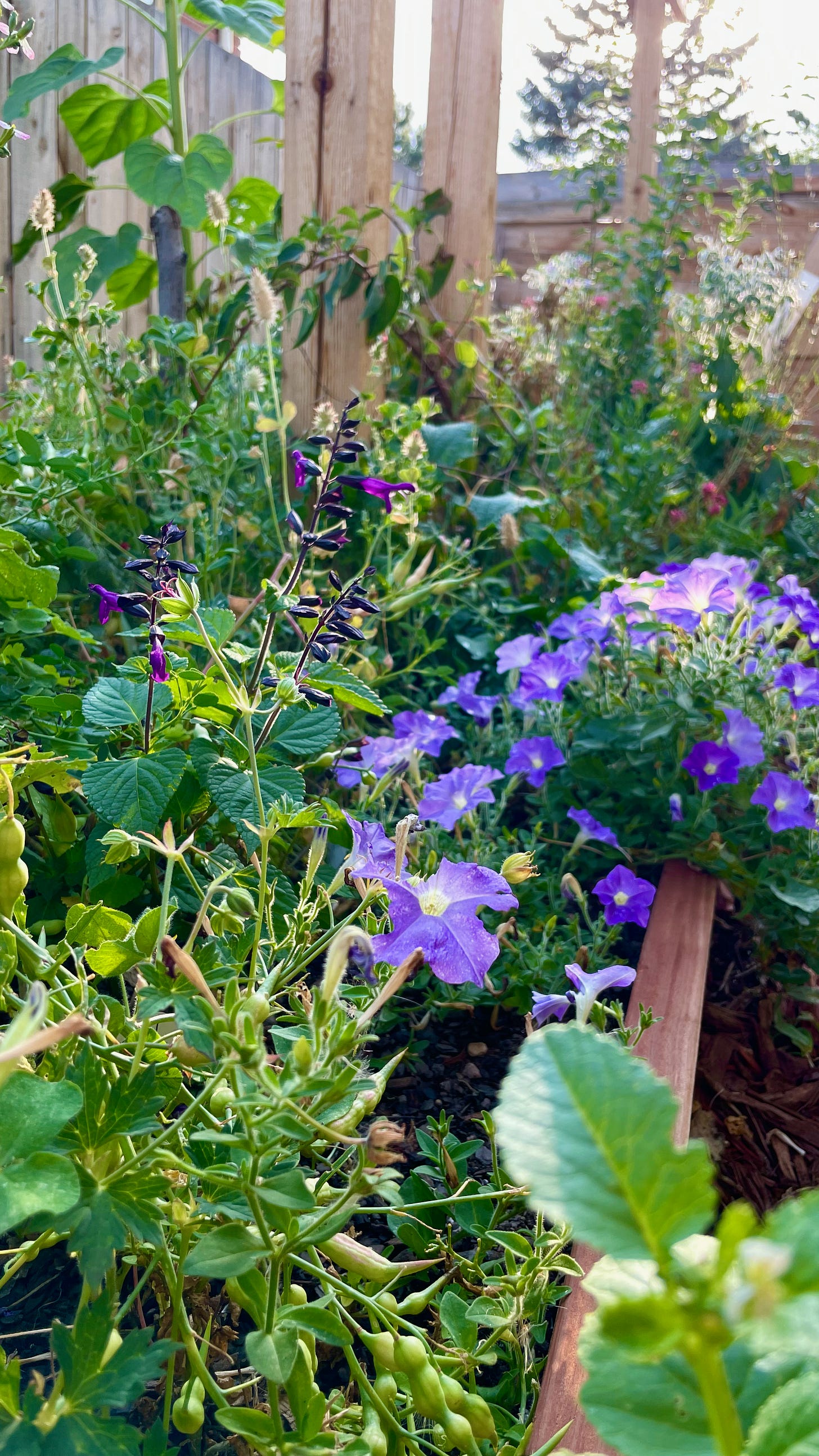If you’ve spent any time in the gardening world recently, you’ve probably heard the buzz about chaos gardening. It has sparked excitement, curiosity, and, yes—even a little controversy.
As with many gardening "hacks," chaos gardening often leads to disappointment. Some people go into chaos gardening with unrealistic expectations. Or perhaps they are lacking some basic fundamental gardening knowledge which makes their choice of plants and seeds unrealistic. And remember: what you see on TikTok and Instagram, isn't always reality!
But it can be an effective gardening strategy in some cases!
As someone who actively uses chaos gardening in my own space, I want to walk you through what it actually is, what people often get wrong about it, how to do it successfully, and what you should really expect from this approach.
Spoiler: it’s not magic—but it can be a lot of fun.
What Is Chaos Gardening?
At its core, chaos gardening is exactly what it sounds like: you mix together a bunch of seeds, scatter them across the soil, and see what grows. It’s gardening without rows, plans, or perfectionism—just the joy of seeing nature do its thing.
It’s an appealing idea for those of us who love low-effort, low-cost experiments in the garden. I often use it in areas where I want ground covered quickly, or where I have leftover seeds that I don’t want to waste.
But here’s the thing: chaos gardening is not the same as naturalistic planting. That’s a big misconception, and it leads to a lot of disappointment.
What Chaos Gardening Isn’t
Let’s clear this up: chaos gardening does not produce the elegant, flowing meadows you see in garden design magazines or on garden designer photo feeds.
This IG reel from Yardfarmer.co was a great response showing that even the design magazines don’t always get it right!
That look—often labeled “naturalistic planting”—requires deep design knowledge, plant spacing strategy, succession planning, and a lot of effort. When people confuse the two, they throw down a mix of seeds, expect magic, and feel let down when it doesn’t look like a curated Piet Oudolf garden.
Naturalistic Garden Designers: These are some of my favorite garden designers who create naturalistic or matrix planting schemes. Their work is gorgeous! And many have books and classes giving you tools to create your own planting schemes.
If you want to achieve that “effortless” wild look, that’s not chaos gardening—you’ll want to check out naturalistic design resources instead. I have some training in this process, and have a DIY Wildlife Garden Guide which gives you resources to get started, a how-to guide, and even a plant list for my Wildlife Garden.
How to Chaos Garden the Right Way
Chaos gardening may be carefree in spirit, but there are some best practices that will help you actually get effective results instead of a patchy mess.
Use the Right Seeds Together
Don’t just dump anything and everything into your mix. Choose seeds that thrive in the same conditions. If the spot is sunny and dry, pick sun-loving drought-tolerant plants. For shady, moist areas, pick shade-tolerant varieties.
Also, group seeds with similar germination depths and spacing needs. For example, leafy greens, radishes, and pollinator-friendly annuals tend to play well together.
Avoid plants that need babying—like tomatoes or cucumbers. They’re not good candidates for chaos gardening, because they require more attention and consistent care to get strong, healthy plants.
Pay Attention to Timing
Don’t toss out warm-weather seeds in early spring and hope for the best. Seeds that aren’t timed right often become bird food or simply never sprout.
Know your germination windows. For early chaos gardening, try fast growers like radishes, clovers, or leafy greens. Save zinnias, cosmos, or sunflowers for when the soil has warmed up.
Use Quality Seed Mixes (or Mix Your Own Smartly)
If you’re new to this, start with a reputable seed mix—like a pollinator blend or wildflower mix from companies like American Meadows or Botanical Interests.
Avoid the cute little seed tins from tourist shops. Those often contain invasive species or plants unsuitable for your zone. And never buy seeds in foreign countries to bring home!
If you’re blending your own, group seeds based on environmental needs and growth habits. Don’t combine aggressive spreaders with delicate growers—they’ll just get crowded out.
Prepare and Protect the Soil
Scatter your seeds over loose soil, then water them in well. I often lay a single layer of burlap over the top to hold in moisture and keep birds from snacking on the seeds before they germinate.
This step makes a big difference in your germination success.
Use It as a Tool, Not a Whole Garden Strategy
I treat chaos gardening as one tool in my gardening toolbox, not my entire plan. I use it to:
Cover bare soil in early spring
Use up leftover or expired seeds
Fill blank spots between perennials
Create a “living mulch” that suppresses weeds
Add variety and surprise to underplanted areas like my orchard
It’s a great way to let nature fill in the gaps, especially when you don’t want to invest too much time or money in a particular space.
Hot Tip: I only use chaos gardening in areas where perennials haven't filled in yet. The perennials provide structure and volume. The seeds provide cover and support.
Of course, if you have a big empty spot and only a little money: go for it! That's a great way to get started. Know, though, that every year will look different. Some plants may reseed or return. But many won't.
Again: have realistic expectations and wait for the wonder!
What to Expect from Chaos Gardening
Chaos gardening is unpredictable by nature. Sometimes you’ll get a burst of color and life that feels like magic. Other times? Not much happens.
That’s part of the charm—and the risk.
If you’re going to try it, go in with the mindset that you’re experimenting. This isn’t the place for your prized heirloom seeds or expensive bulbs. Use it as a way to play, explore, and let go of control.
When it works, it’s incredibly satisfying. When it doesn’t, well—you’ve likely only lost a handful of seeds and a bit of time.
My Favorite Chaos Gardening Plants
Here are a few winners I return to again and again:
🌿 Greens & Veggies
Cut-and-come-again lettuces
Baby leaf mixes
Radishes (especially daikon)
Turnips
Clover (as a soil builder and living mulch)
🌸 Flowers
Borage
Nasturtiums
Cosmos
Zinnias
Sunflowers (in warm climates)
As always, I lean into the Native North American plants as much as possible!
Embrace the Fun of Chaos
If you take anything from this post, I hope it’s this: gardening should be joyful.
Chaos gardening is a great way to embrace that joy. It's an invitation to experiment, to loosen up, and to let nature surprise you. It’s not about perfection—it’s about participation.
So grab those seeds, mix them up, and throw them into the wind (okay, the soil—but you get my point). Then sit back, water a little, and see what happens.
If you’ve tried chaos gardening—or are thinking about giving it a go—I’d love to hear how it works out for you. Drop a comment below and let me know what grew!
And if you found this post helpful, share it with a fellow gardener and be sure to check out my other tips for creating a thriving, low-stress garden.
Happy gardening! 🌱
Angela











Most excellent tool! Rather like planned Impressionistic painting. What a lovely way to let go.
But for control freaks, and especially us ex ICU RNs who live in the arid So California with less than 12 inches yearly, there is something I like to call "Dryland Chinampas Aquaponic Gardening.
You too can have your very own ICU Patient sunbathing in your back yard and revive your patient technical skills of oxygenation, nutrition, filtration, pH monitoring, clelated Iron administration, Preload/Afterload (actually pond pump 'head height') and volume management during retirement. And guarded by weed patrolling 'feathered/winged goats' called Muscovy.
All in the name of 'extreme gardening'.
Your methods are far less scary than mine, but Curiosity and insane hopes tie all gardeners together, right?
Pat Browne, RN/B. Animal Science Tropical Agriculture
Well, now I need to come see your garden!! Fascinating! ❤️